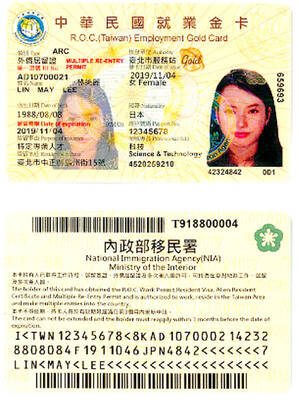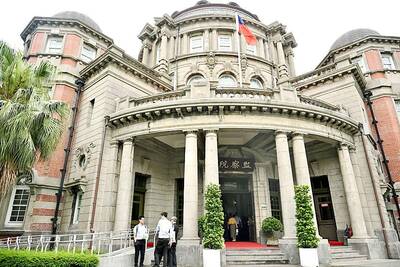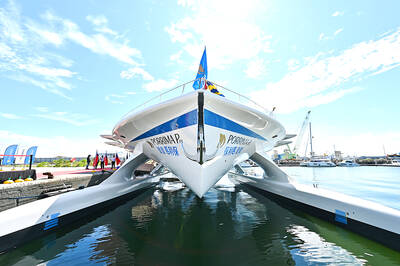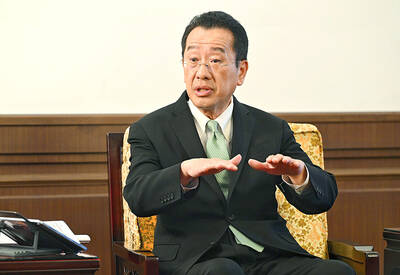United Microelectronics Corp (聯電), the world's second largest chip contractor, jointly announced with IBM and Infineon Technologies AG yesterday that they have started production of chips using the most advanced 0.13-micron foundry process technology currently available.
First customer shipments of the high performance chips for network communications and computing applications are expected early next year, the companies said in a press statement released yesterday. A variety of logic and mixed-signal chips are now in initial production at IBM facilities in the US, Infineon in Europe, and UMC manufacturing lines in Taiwan.
Production of the highly advanced technology process should attract orders from integrated device manufacturers in the longer term, analysts said. But the slowdown in the world chip market may dampen any benefits for UMC in the shorter term.
"From the technological perspective, this is good news because it means UMC's capability has reached what is currently the most advanced level," said Thomas Chen, senior analyst at Polaris Securities Co. That should be helpful in getting orders from IDMs in the long term, he said. However, in the short term, "The speed of IDM outsourcing will slow in line with the market slowdown," he said.
The slowdown in PC demand, lower than expected mobile phone demand, and a slowing US economy has resulted in lowered profit expectations, increasing inventories, and analysts' downgraded predictions for major technology companies in the US and Taiwan.
Profits generated by the 0.13 micron technology will also be limited because the proportion of chip production using the advanced manufacturing process remains low, analysts said.
The technology, which is jointly developed, is designed to meet the high performance and low power consumption demands of advanced customer chip designs by using true low-k dielectric insulation and the highest number of copper wiring layers, the companies said yesterday. The technology also continues the semiconductor industry's trend toward smaller, faster, more highly-integrated chip designs.
However, the utilization rate for both UMC and competitor Taiwan Semiconductor Manufacturing Co's (TSMC,
As a result, UMC has established programs such as its recently introduced Silicon Shuttle program for 2001 to help accelerate the adoption of the more advanced 0.13 micron technology process by its customers.
The decision by major electronic manufacturing services provider Flextronics International to join UMC's preferred foundry program benefits Flextronics by speeding up its service to its clients, who include Cisco Systems, Nortel Networks and Nokia.
The strategic move, which UMC announced on Monday, may also benefit UMC in ways beyond recognition of its advanced technology, analysts said.
"Maybe UMC wants to use the strategy to encourage its customers to use more advanced processes," said Ken Cheng, an analyst at China Securities Co. "In the longer term, it is a triumph that that the advanced process will be used," he said.
Indeed, customers are already showing strong interest in the new 0.13 micron technology, said Liou Fu-tai, senior vice president and chief technology officer of UMC. "UMC has already taped-out Silicon Shuttle test wafers carrying the designs of five customers," said Liou.
The Silicon Shuttle program offers customers the opportunity to verify their advanced designs and prototypes in UMC silicon, helping to minimize risks and costs.
The 2001 program introduced last week includes the 0.13 micron platform. "We have more than 16 additional foundry customers who have started their designs for this technology and will start initial production in the first quarter and second quarter of next year," said Liou. "With both IBM and Infineon reporting similar customer interest, it is clear that this technology is rapidly gaining acceptance as the premier global foundry solution for the implementation of advanced integrated circuits."
Analysts see the announcement as positive in the longer term, especially in the development of central processing units and communication chips.
"If you're a long-term investor, you have to take note of this," said China Securities' Cheng.
But with investors more concerned about short term factors such as the utilization rate of UMC and TSMC next year and recent analyst downgrades of the two companies, analysts don't anticipate UMC's stock price to benefit from the announcement for now.

GAINING STEAM: The scheme initially failed to gather much attention, with only 188 cards issued in its first year, but gained popularity amid the COVID-19 pandemic Applications for the Employment Gold Card have increased in the past few years, with the card having been issued to a total of 13,191 people from 101 countries since its introduction in 2018, the National Development Council (NDC) said yesterday. Those who have received the card have included celebrities, such as former NBA star Dwight Howard and Australian-South Korean cheerleader Dahye Lee, the NDC said. The four-in-one Employment Gold Card combines a work permit, resident visa, Alien Resident Certificate (ARC) and re-entry permit. It was first introduced in February 2018 through the Act Governing Recruitment and Employment of Foreign Professionals (外國專業人才延攬及雇用法),

WARNING: From Jan. 1 last year to the end of last month, 89 Taiwanese have gone missing or been detained in China, the MAC said, urging people to carefully consider travel to China Lax enforcement had made virtually moot regulations banning civil servants from making unauthorized visits to China, the Control Yuan said yesterday. Several agencies allowed personnel to travel to China after they submitted explanations for the trip written using artificial intelligence or provided no reason at all, the Control Yuan said in a statement, following an investigation headed by Control Yuan member Lin Wen-cheng (林文程). The probe identified 318 civil servants who traveled to China without permission in the past 10 years, but the true number could be close to 1,000, the Control Yuan said. The public employees investigated were not engaged in national

The zero emissions ship Porrima P111 was launched yesterday in Kaohsiung, showcasing the nation’s advancement in green technology, city Mayor Chen Chi-mai (陳其邁) said. The nation last year acquired the Swiss-owned vessel, formerly known as Turanor PlanetSolar, in a bid to boost Taiwan’s technology sector, as well as ecotourism in Palau, Chen said at the ship’s launch ceremony at Singda Harbor. Palauan President Surangel Whipps Jr and Minister of Foreign Affairs Lin Chia-lung (林佳龍) also attended the event. The original vessel was the first solar-powered ship to circumnavigate the globe in a voyage from 2010 to 2012. Taiwan-based Porrima Inc (保利馬) installed upgrades with

ENHANCE DETERRENCE: Taiwan has to display ‘fierce resolve’ to defend itself for China to understand that the costs of war outweigh potential gains, Koo said Taiwan’s armed forces must reach a high level of combat readiness by 2027 to effectively deter a potential Chinese invasion, Minister of National Defense Wellington Koo (顧立雄) said in an interview with the Chinese-language Liberty Times (sister newspaper of the Taipei Times) published yesterday. His comments came three days after US Secretary of State Marco Rubio told the US Senate that deterring a Chinese attack on Taiwan requires making a conflict “cost more than what it’s worth.” Rubio made the remarks in response to a question about US policy on Taiwan’s defense from Republican Senator John Cornyn, who said that Chinese